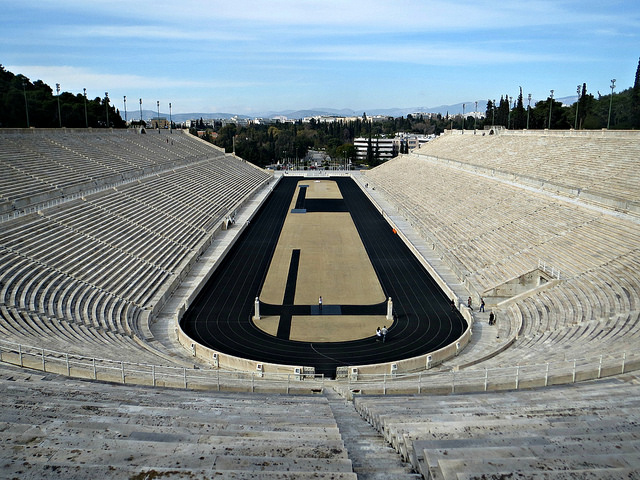42.195 km or 26 miles and 385 yards. Those numbers are familiar to the hundreds of thousands of people, who take up running as a sport.
It is the distance of a Marathon Race. Many runners know that it commemorates the Battle of Marathon in ancient Greece. However, there are some surprising facts, when you look at the historic Marathon route.
The first race
The first Marathon Race was held in 1896 for the Olympic Games in Athens.
The organizers were looking for a spectacular event and chose a long distance race based on the legendary Battle of Marathon.
In 490 BC about 10,000 Greek soldiers defeated a much larger force of invading Persians on the plains of Marathon and forced them back on their ships. Legend has it that a warrior was sent from the victorious Greeks to Athens to bring the news to their city. He delivered his message and dropped dead from the exhaustion.
The Olympic planners started the race at the village of Marathon, going south along the coast and passing Mount Pentelicus in the south. The route continued west-wards into Athens, with the finish in the Olympic Stadium. The route had a total length of about 40 km and the race was won by a Greek water carrier, Spyridon Louis, who finished in just under 3 hours.
The new event was a success! It was repeated at the Olympic Games to follow and gained enormous popularity for the last 120 years.
The length of the race
If you look at the story behind the race, you would expect that the messenger sent by the Greeks started from the battle site and ran to somewhere around the Acropolis in the historic center of Athens.
The battle site is well known. There is a mound, where the dead soldiers from the battle were buried. It is located about 2 km south of the village of Marathon near the beach, where the battle ended. From here, the route to Athens is about 37 km.
If the length of a Marathon race is based on the legendary story of the messenger, 37 km would probably the historical distance.

The famed 42.195 kilometers of today’s marathon races on the other hand were set in 1921 based on the length of race at the 1908 London Olympics. The route ran from Windsor Castle to the Olympic Stadium in London and was described as “about 26 miles plus 385 yards on the track” of the stadium.
This does not quite justify the implied precision of 42 kilometers and 195 meters. Current race courses are more accurately measured, allowing a tracking error of 1 meter per kilometer.
A closer look at the legendary runner
While today’s distance might not be historically accurate, let’s look at person behind the legendary story.
Plutarch, a Greek writer, who lived more than 500 year after the events (46-120 AD) is one of the oldest sources of the story of the messenger, who dropped dead after the race. It became popular and obviously inspired today’s Marathon Race.
Another Greek writer, the famous historian Herodotus, who wrote less than 50 years after the battle about the events, tells a different story:
When the Athenians learned about the invasion that led to the Battle of Marathon, they send a messenger to Sparta to ask for support.
This messenger, by the name of Pheidippides, was a professional running courier, a special profession in ancient Greece.
Herodotus writes that Pheidippides arrived in Sparta, the day after he left Athens. He covered a distance of about 250 km.
He delivered his message, received the – unsatisfactory – answer and ran back to Athens.
That is some very impressive running!
While Pheidippides was busy delivering his messages, the Greek soldiers pushed back the Persians onto their ships at Marathon. They were victorious, however feared that the escaped Persians would take their ships to Athens and attack the city.
Herodotus writes that the Greek army as a whole marched back to Athens – some 37 km as discussed above.
It is quite possible that these events got mixed up over time and at the time of Plutarch, the dramatic story of the single messenger from the battle took hold.
Commemorating long-distance runners
Herodotus version however was not lost and in 1982 a group of British soldiers took on the challenge to repeat Pheidippides’ run to Sparta. They succeeded and it took them a day and a half – just as described by Herodotus some 2,500 years ago.
This route was named Spartathlon and there is a popular long-distance race held every September at the historical season for Pheidippides’ run.
The Spartathlon race is probably closest to the events that happened 2,500 years ago. It commemorates the feat of Pheidippides and the profession of ancient long-distance runners.
Marathon Races as we know them today however, are a powerful motivation for many people to improve their lives by doing sport – regardless of the historical accuracy of the story.
Then sign up for our free email newsletter to get all our new posts right to your inbox.
